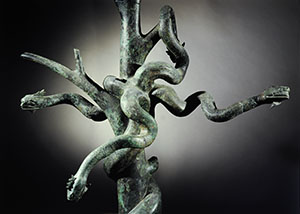 |
||
| [close] | ||
 |
© Institute and Museum of the History of Science |
Fountain portraying the Hydra of LernaBronze, first half of the 1st cent. B.C. Herculaneum, piscina of the Palaestra Soprintendenza Archeologica di Pompei, inv. 79242 The great bronze fountain, casted by the lost wax technique, was found in 1952 in the cruciform pool of the Palaestra or Campus of Herculaneum, a great complex built in the Augustan-Tiberian Age and equipped not only for exercise and sports competitions but also for intellectual activities and religious ceremonies. According to mythology, Heracles defeated the Hydra of Lerna, in the Argolid (Greece), cutting off its heads and scorching each of the wounds to keep them from growing back. The fountain of the Hydra, alluding to one of the Labours of the hero who founded the city, lauded Heracles' valour as an example to be emulated by the local youths, who probably gathered in this building. In the Herculaneum sculpture, every single head of the serpent served as a fountain mouth. Water flew through a tube placed inside the tree trunk and reached each head thanks to bypasses crossing the monster's coils. |